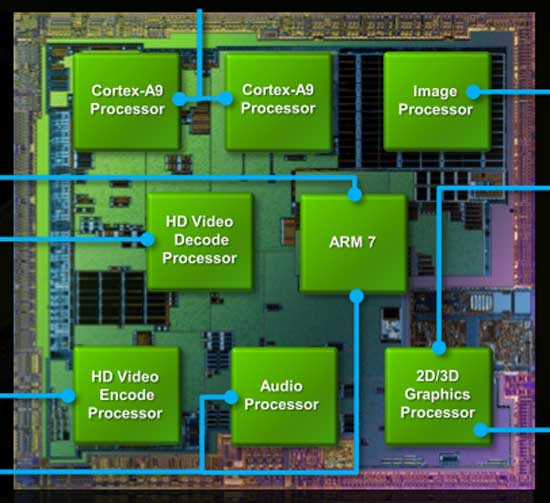To: All
From Anandtech...Jan 2010:
NVIDIA Introduces dual Cortex A9 based Tegra 2
********************************EXCERPT************************************
In order to compete in that space you need a competent chip. Today NVIDIA is announcing its second generation Tegra SoC. It's creatively named the Tegra 2 and this is what it looks like in block diagram form:

The SoC is made up of 8 independent processors, up from 7 in the original Tegra. The first two are the most exciting to me - a pair of ARM Cortex A9 cores. These are dual-issue out of order cores from ARM running at up to 1GHz. If you thought the A8 was fast, these things should be much faster.
The original Tegra used a single ARM11 core. It was multi-core capable but the only version NVIDIA ever shipped only had a single ARM11. By now you know that ARM11 is unreasonably slow and thus you see my biggest problem with Tegra 1. Tegra 2 addresses this in a grand way. NVIDIA skipped over Cortex A8 entirely and went to what it believes is a more power efficient, higher performing option with the A9. I'll go deeper into the A9's architecture shortly, but to put it bluntly - A8 is dead in my eyes, Cortex A9 is what you want.
To: All
From the Forbes article:
NVIDIA Seen As Big Winner In 2011 Tablets
********************************EXCERPT************************************
Dec. 13 2010 -
Next year looks to be much more productive in terms of mobile devices. Tegra chips have already been spotted in several soon-to-launch, highly anticipated gadgets, including Motorola’s first tablet and LG’s Android-based “Star” phone.
NVIDIA may have picked up another, more surprising customer recently: Samsung. Srivastava said he thinks the next Samsung Galaxy tablet will be based on an NVIDIA chip. Up to now, Samsung has relied on its own processors, which it calls Hummingbird, to power its Galaxy line of smartphones and tablets.
To: Ernest_at_the_Beach
Interesting strategy. Hummingbird (Samsung Galaxy) has an ARM core plus 2D/3D, and relies on the ARM’s SIMD to do the video encoding and decoding. Apple’s A4 adds hardware video decoding to save battery life. This goes further adding hardware video encoding. But it’ll be at the cost of an overall larger chip, but probably offset by Moore’s Law. IMHO, this will rock. No longer will video recording suck up your battery.
Apple had better have something serious in the works for the A5, or they’re going to be way behind.
FreeRepublic.com is powered by software copyright 2000-2008 John Robinson
